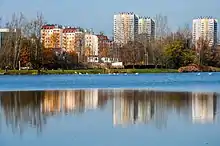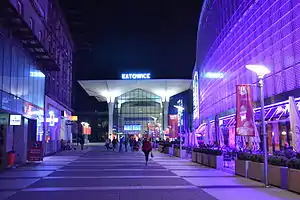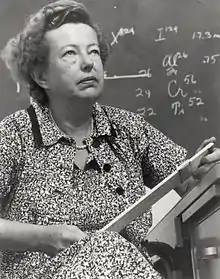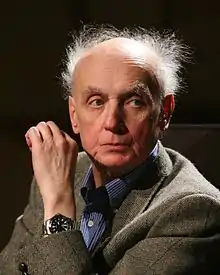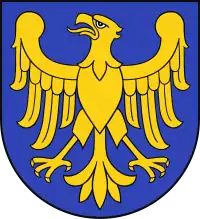Katowice
Katowice (UK: /ˌkætəˈviːtsə/ KAT-ə-VEET-sə,[3] US: /ˌkɑːt-/ KAHT-,[4] Polish: [katɔˈvitsɛ] (![]() listen); Silesian: Katowicy; German: Kattowitz) is a city in southern Poland, the capital city of the Silesian Region, and a center of the Upper Silesia and Dąbrowa Basin Metropolis. With a population of 292,774 as of 2019,[1] it is the eleventh-largest city in Poland. The wider Katowice urban area has a population of 2–3 million people.
listen); Silesian: Katowicy; German: Kattowitz) is a city in southern Poland, the capital city of the Silesian Region, and a center of the Upper Silesia and Dąbrowa Basin Metropolis. With a population of 292,774 as of 2019,[1] it is the eleventh-largest city in Poland. The wider Katowice urban area has a population of 2–3 million people.
Katowice
| |
|---|---|
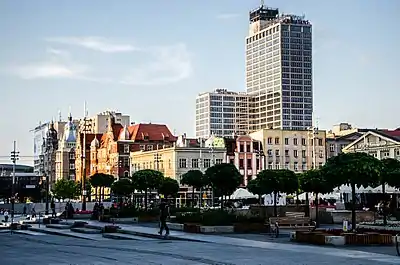 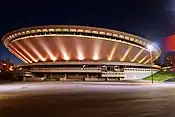 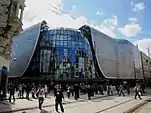 _(Moderus_Rynek_Katowice).jpg.webp) 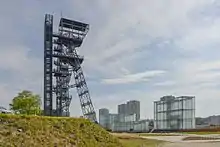 _Lichen99.jpg.webp)
| |
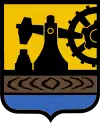 Coat of arms | |
 Katowice Location of Katowice in the Silesia Province in mid-southern Poland 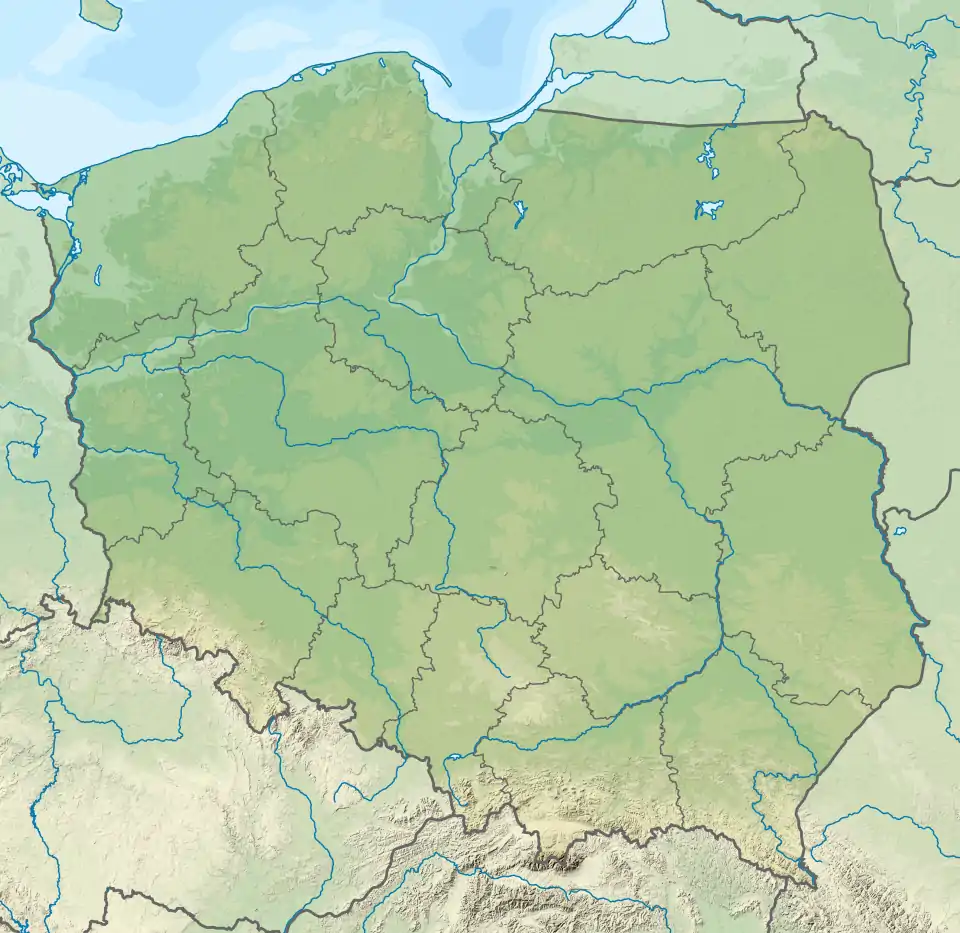 Katowice Katowice (Poland) | |
| Coordinates: 50°15′30″N 19°01′39″E | |
| Country | |
| Voivodeship | |
| County | city county |
| Established | 16th century – 1598 first official information |
| City rights | 1865 |
| Government | |
| • Mayor | Marcin Krupa |
| Area | |
| • City | 164.67 km2 (63.58 sq mi) |
| • Metro | 5,400 km2 (2,100 sq mi) |
| Highest elevation | 352 m (1,155 ft) |
| Lowest elevation | 266 m (873 ft) |
| Population (31 December 2019) | |
| • City | 292,774 |
| • Density | 1,780/km2 (4,600/sq mi) |
| • Urban | 2,710,397 |
| • Metro | 5,294,000[2] |
| Time zone | UTC+1 (CET) |
| • Summer (DST) | UTC+2 (CEST) |
| Postal code | 40-001 to 40–999 |
| Area code(s) | +48 32 |
| Vehicle registration | SK |
| Website | www |
Throughout the mid-18th century, Katowice developed into a village following the discovery of rich coal reserves in the area. In 1742 the First Silesian War transferred Upper Silesia, including Katowice, to Prussia. Many German or Prussian craftsmen, merchants and artists began to settle in the region, which had been inhabited mostly by Poles over the past hundreds of years. Silesia also experienced an influx of Jewish settlers. In the first half of the 19th century, intensive industrialization transformed local mills and farms into industrial steelworks, mines, foundries and artisan workshops. This transformation also contributed to the establishment of companies and eventual rapid growth of the city.[5] At the same time, Katowice became linked to the railway system with the first train arriving at the main station in 1847.[6]
The outbreak of World War I was favourable for Katowice due to the prospering steel industry.[7] Following Germany's defeat and the Silesian uprisings, Katowice and parts of Upper Silesia were annexed by the Second Polish Republic.[8] Poland was then backed by the Geneva Convention and the ethnic Silesian minority. On 3 May 1921, the Polish army entered Katowice and the Polish administration took control. The city became the capital of the autonomous Silesian Voivodeship as well as the seat of the Silesian Parliament and Committee of Upper Silesia. After the plebiscite, many former German citizens emigrated; however, a vibrant German community remained until the end of World War II. In 1939, after the Wehrmacht seized the town, Katowice and the provinces were incorporated into the Third Reich. The town was eventually liberated by the Soviet army on 27 January 1945.[9]
Katowice is a center of science, culture, industry, business, trade, and transportation in Upper Silesia and southern Poland, and the main city in the Upper Silesian Industrial Region. Katowice lies within an urban zone, with a population of 2,746,460 according to Eurostat,[10] and also part of the wider Silesian metropolitan area, with a population of 5,008,000 according to the Brookings Institution[11] or 5,294,000 according to the European Spatial Planning Observation Network.[2]
In 2020, the city is classified as a Gamma - global city by the Globalization and World Cities Research Network[12] and is considered as an emerging metropolis.[13] The whole metropolitan area is the 16th most economically powerful city by GDP in the European Union with an output amounting to $114.5 billion.[14]
Katowice is the seat of the Polish National Radio Symphony and Orchestra. It also hosts the finals of Intel Extreme Masters, an Esports video game tournament. In 2015, Katowice joined the UNESCO Creative Cities Network and was named a UNESCO City of Music.[15]
History
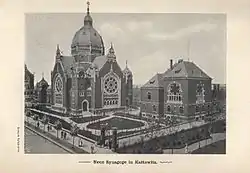
The area around Katowice, in Upper Silesia, has been inhabited by ethnic Silesian tribes from its earliest documented history.[16] Initially it was ruled by the Polish Silesian Piast dynasty until its extinction.[5] The settlement of the area surrounding Katowice dates back to the end of the 12th century. From 1138, the Bytom castellany encompassed territories where Katowice is now located. In 1177 the lands were legally handed over by Duke Casimir II the Just to his nephew Mieszko I Tanglefoot; this justified their incorporation into the medieval Silesian provinces. At the turn of the 14th century, new villages called Bogucice, Ligota, Szopenice and Podlesie were established, as well as the village of Dąb, mentioned in 1299 in a document issued by Duke Casimir of Bytom.
From 1327, the region was under administration of the Kingdom of Bohemia under the Holy Roman Empire. In historical documents dating from 1468, there was a reference to the settlement of Podlesie, which, at present, is one of the city districts, whereas the village of Katowice (or "Katowicze" in older records) was first mentioned in the year 1598. Historians assume that Katowice was founded on the right bank of the Rawa river by Andrzej Bogucki in around 1580.

.jpg.webp)
In 1598 a village called Villa Nova was also documented to stand in the area now occupied by the city of Katowice. By this time the territory had changed from the Bohemian Crown to the domain of the Austrian Habsburg dynasty.[17]
Kattowitz gained city status in 1865 in the Prussian Province of Silesia.[16] The city flourished due to large mineral (especially coal) deposits in the nearby mountains. Extensive city growth and prosperity depended on the coal mining and steel industries, which took off during the Industrial Revolution. The city was inhabited mainly by Germans, Silesians, Jews and Poles. In 1884, 36 Jewish Zionist delegates met here, forming the Hovevei Zion movement. Previously part of the Beuthen district, in 1873 it became the capital of the new Kattowitz district. On 1 April 1899, the city was separated from the district, becoming an independent city.
_(Katowice%252C_3_Maja).jpg.webp)
Under the Treaty of Versailles after World War I, the Upper Silesia plebiscite was organised by the League of Nations. Though Kattowitz proper voted 22,774 to remain in Germany and 3,900 for Poland,[18] it was attached to Poland as the larger district voted 66,119 for Poland and 52,992 for Germany.[19] Following the Silesian uprisings of 1918–21 Katowice became part of the Second Polish Republic with some autonomy for the Silesian Parliament as a constituency and the Silesian Voivodeship Council as the executive body).
During the early stages of World War II and the Poland Campaign, Katowice was essentially abandoned, as the Polish Army had to position itself around Kraków. Under the Nazi occupation many of the city's historical and iconic monuments were destroyed, most notably the Great Katowice Synagogue, which was burned to the ground on 4 September 1939. This was followed by the alteration of street names and the introduction of strict rules. Additionally, the use of Polish in public conversations was banned. The German administration was also infamous for organising public executions of civilians[20] and by the middle of 1941, most of the Polish and Jewish population was expelled. Eventually, Katowice was occupied by the Red Army in January 1945. Significant parts of the downtown and inner suburbs were demolished during the occupation. This, however, cannot be compared with Warsaw, where the level of destruction reached 85%.[21] As a result, the authorities were able to preserve the central district in its prewar character.
The postwar period of Katowice was characterised by the time of heavy industry development in the Upper Silesian region, which helped the city in regaining its status as the most industrialised Polish city and a major administrative centre. As the city developed so briskly, the 1950s marked a significant increase in its population and an influx of migrants from the Eastern Borderlands, the so-called Kresy. The city area began to quickly expand by incorporating the neighbouring communes and counties. However, the thriving industrial city also had a dark period in its short but meaningful history. Most notably, between 7 March 1953 and 10 December 1956, Katowice was called Stalinogród in honour of Joseph Stalin, leader of the Soviet Union.[22] The change was brought upon by an issued decree of the State Council.[23] The date of the alteration of the city name was neither a coincidence or accidental as it happened on the day of Stalin's death. In this way, the Polish Communist Party and the socialist authority wanted to pay tribute to the dictator. The new name never got accepted by the citizens and in 1956 the former Polish name was restored.[24]
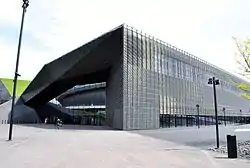

The following decades were more memorable in the history of Katowice. Regardless of its industrial significance, it started to become an important cultural and educational centre in Central and Eastern Europe. In 1968 the University of Silesia, the largest and most valued college in the area, was founded. Simultaneously the construction of large housing estates began to evolve. Furthermore, many representative structures were erected at that time, including the Silesian Insurgents' Monument (1967) and Spodek (1971), which have become familiar landmarks and tourist sights. The 1960s and 1970s saw the evolution of modernist architecture and functionalism. Katowice eventually developed into one of the most modernist post-war cities of Poland.
One of the most dramatic events in the history of the city occurred on 16 December 1981. It was then that 9 protesters died (7 were shot dead; 2 died from injury complications) and another 21 were wounded in the pacification of Wujek Coal Mine. The Special Platoon of the Motorized Reserves of the Citizens' Militia (ZOMO) was responsible for the brutal handling of strikers protesting against Wojciech Jaruzelski's declaration of martial law and the arrest of Solidarity trade union officials. On the 10th anniversary of the event, a memorial was unveiled by the President of Poland Lech Wałęsa.
In 1990 the first democratic local elections that took place marked a new period in the city's history. The economy of Katowice has been transforming from the heavy industry of steel and coal mines into "one of the most attractive investment areas for modern economy branches in Central Europe".[25] Recently, the city's efficient infrastructure, rapid progress in the overall development and an increase in office space has made Katowice a popular venue for conducting business. The Katowice Expo Centre (Katowickie Centrum Wystawiennicze) organises trade fairs or exhibitions and attracts investors from all over the world.[26]
Geography
Katowice is a city in Upper Silesia in southern Poland, on the Kłodnica and Rawa rivers (tributaries of the Oder and the Vistula respectively). It is in the Silesian Highlands, about 50 km (31 mi) north of the Silesian Beskids (part of the Carpathian Mountains) and about 100 km (62 mi) southeast of the Sudetes Mountains. Katowice is in the Katowice Highlands, part of the Silesian Highlands, in the eastern part of Upper Silesia, in the central portion of the Upper Silesian Coal Basin. Katowice is an urban community in the Silesian Voivodeship in south-west Poland. It is central district of the Silesian Metropolis—a metropolis with a population of two million. It borders the cities of Chorzów, Siemianowice Śląskie, Sosnowiec, Mysłowice, Lędziny, Tychy, Mikołów, Ruda Śląska and Czeladź. It lies between the Vistula and Oder rivers. Several rivers flow through the city, the major two being the Kłodnica and Rawa. Within 600 km (370 mi) of Katowice are the capital cities of six countries: Berlin, Vienna, Prague, Bratislava, Budapest and Warsaw.
Climate
Katowice has a temperate, ocean-moderated humid continental climate (Köppen climate classification: Dfb/Cfb). The average temperature is 8.2 °Celsius (−2.0 °C or 28.4 °F in January and up to 17.9 °C or 64.2 °F in July). Yearly rainfall averages at 652.8 millimetres or 25.70 inches. Characteristic weak winds blow at about 2 metres per second (4.5 mph; 7.2 km/h; 3.9 kn) from the west, the Moravian Gate.[27]
| Climate data for Katowice | |||||||||||||
|---|---|---|---|---|---|---|---|---|---|---|---|---|---|
| Month | Jan | Feb | Mar | Apr | May | Jun | Jul | Aug | Sep | Oct | Nov | Dec | Year |
| Record high °C (°F) | 14.6 (58.3) |
18.8 (65.8) |
23.0 (73.4) |
28.2 (82.8) |
32.2 (90.0) |
34.6 (94.3) |
35.4 (95.7) |
37.2 (99.0) |
34.9 (94.8) |
26.6 (79.9) |
22.5 (72.5) |
18.2 (64.8) |
37.2 (99.0) |
| Average high °C (°F) | 0.9 (33.6) |
2.5 (36.5) |
7.4 (45.3) |
13.4 (56.1) |
18.7 (65.7) |
21.5 (70.7) |
23.4 (74.1) |
23.2 (73.8) |
18.6 (65.5) |
13.5 (56.3) |
6.8 (44.2) |
2.2 (36.0) |
12.7 (54.8) |
| Daily mean °C (°F) | −2.0 (28.4) |
−1.1 (30.0) |
2.9 (37.2) |
8.1 (46.6) |
13.2 (55.8) |
16.3 (61.3) |
17.9 (64.2) |
17.5 (63.5) |
13.3 (55.9) |
8.7 (47.7) |
3.5 (38.3) |
−0.5 (31.1) |
8.2 (46.7) |
| Average low °C (°F) | −5.3 (22.5) |
−4.7 (23.5) |
−1.5 (29.3) |
2.5 (36.5) |
7.1 (44.8) |
10.5 (50.9) |
12.2 (54.0) |
11.8 (53.2) |
8.1 (46.6) |
4.1 (39.4) |
0.2 (32.4) |
−3.5 (25.7) |
3.5 (38.2) |
| Record low °C (°F) | −31.0 (−23.8) |
−30.0 (−22.0) |
−21.0 (−5.8) |
−8.2 (17.2) |
−4.0 (24.8) |
0.0 (32.0) |
4.8 (40.6) |
1.7 (35.1) |
−2.0 (28.4) |
−9.0 (15.8) |
−16.3 (2.7) |
−24.4 (−11.9) |
−31.0 (−23.8) |
| Average precipitation mm (inches) | 32.8 (1.29) |
34.5 (1.36) |
36.7 (1.44) |
49.6 (1.95) |
62.9 (2.48) |
79.9 (3.15) |
90.7 (3.57) |
65.5 (2.58) |
58.4 (2.30) |
52.1 (2.05) |
48.1 (1.89) |
41.6 (1.64) |
652.8 (25.7) |
| Average precipitation days | 11.9 | 11.6 | 11.9 | 11.9 | 11.8 | 13.4 | 12.3 | 10.9 | 11.1 | 11.3 | 13.3 | 13.9 | 145.3 |
| Source: climatebase.ru[28] | |||||||||||||
Districts
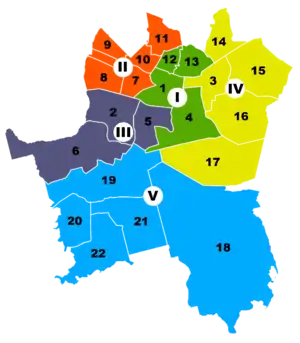
|
|
Conurbation
Katowice lies in the centre of the largest conurbation in Poland, one of the largest in the European Union, numbering about 2.7 million. The Katowice urban area consists of about 40 adjacent cities and towns, the whole Silesian metropolitan area (mostly within the Upper Silesian Coal Basin) over 50 cities or towns. The metropolitan area has a population of 5,294,000. In 2006, Katowice and 14 adjacent cities united as the Upper Silesian Metropolis. Its population is 2 million and its area is 1,104 km². In 2006–2007 the union planned to unite these cities in one city under the name "Silesia", but this proved unsuccessful.[29]
The Katowice conurbation comprises settlements which have evolved because of the mining of metal ores, coal and raw rock materials.[30] The establishment of mining and heavy industry which have developed for the past centuries has resulted in the unique character of the cityscape; its typical aspects are the red brick housing estates[31] constructed for the poorer working class, factory chimneys, manufacturing plants, power stations and quarries. The inhabitants of a large mining community like Katowice, and local administrations within the conurbation, which have only evolved due to mining, are a subject to overall decline after the liquidation of coal mines and factories. This is one of the reasons which led to the development of the service sector, including office spaces, shopping centres and tourism.
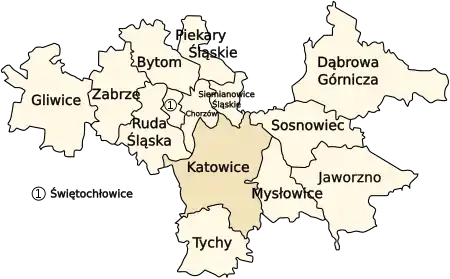
| District | Population[32] (30 June 2017) | Area (km²) | Density (km²) |
|---|---|---|---|
| Katowice | 297,197 | 164.67 | 1,896 |
| Sosnowiec | 204,958 | 91.06 | 2,444 |
| Gliwice | 181,715 | 133.88 | 1,474 |
| Zabrze | 175,016 | 80.40 | 2,352 |
| Bytom | 168,968 | 69.44 | 2,661 |
| Ruda Śląska | 138,754 | 77.73 | 1,860 |
| Tychy | 128,191 | 81.64 | 1,590 |
| Dąbrowa Górnicza | 121,387 | 188.73 | 682 |
| Chorzów | 109,151 | 33.24 | 3,420 |
| Jaworzno | 92,215 | 152.67 | 626 |
| Mysłowice | 74,600 | 65.75 | 1,139 |
| Siemianowice Śląskie | 67,710 | 25.5 | 2,809 |
| Piekary Śląskie | 55,820 | 39.98 | 1,477 |
| Świętochłowice | 50,529 | 13.31 | 4,097 |
Demographics
| Year | Pop. | ±% |
|---|---|---|
| 1783 | 294 | — |
| 1845 | 1,326 | +351.0% |
| 1870 | 6,780 | +411.3% |
| 1897 | 25,000 | +268.7% |
| 1910 | 43,173 | +72.7% |
| 1924 | 112,822 | +161.3% |
| 1939 | 134,000 | +18.8% |
| 1945 | 107,735 | −19.6% |
| 1950 | 175,496 | +62.9% |
| 1955 | 199,907 | +13.9% |
| 1960 | 269,926 | +35.0% |
| 1970 | 305,000 | +13.0% |
| 1980 | 355,117 | +16.4% |
| 1987 | 368,621 | +3.8% |
| 1997 | 348,974 | −5.3% |
| 2009 | 308,724 | −11.5% |
| 2015 | 299,910 | −2.9% |
| 2017 | 297,197[32] | −0.9% |
Główny Urząd Statystyczny, Polish statistical office, estimates Katowice's population to be 292,774 as of December 31, 2020, with a population density of 1,778 people/sq km (4,605 people/sq mi). There were 139,274 males and 153,500 females. Age breakdown of people in Katowice is: 12.9% 0-14 years old, 13.7% 15-29 years old, 23.8% 30-44 years old, 19.5% 45-59 years old, 20.1% 60-74 years old, and 9.9% 75 years and older.
Katowice is a center of the Upper Silesian metropolitan area, with a population of approx. 5.3 million. This metropolitan area extends into the neighboring Czechia, where the other center is the city of Ostrava. 41 municipalities that constitute the core of the metropolitan area created the Silesian Metropolis association, which has 2.3 million people as of 2019.
Historical population
Katowice's population grew very fast between 1845 and 1960, fueled by the expansion of heavy industry and administrative functions. In the 60s, 70s and 80s the city grew by another 100,000 people to reach a height of 368,621 in 1988. Since then, the collapse of heavy industry, emigration, and suburbanization reversed the population development; Katowice lost approx. 75,000 people (20%) since the fall of communism in Poland.
Prior to the Second World War, Katowice was mainly inhabited by Poles and Germans. The 1905 Silesian demographic census has shown that Germans made up nearly 75% of the total population. Following Germany's defeat in 1945, the large German majority was forced to flee. Most pre-war citizens (excluding Poles) were violently expelled by the new authorities. This resulted in a large group of exiled Silesians living in present-day Germany, creating a new association of Landsmannschaft Schlesien. One of its most notable spokesmen and leaders was the Christian Democratic Union politician Herbert Hupka.[33]
During the war, the Nazi occupant committed severe crimes against the local Gypsy and Jewish communities. Most of them were eventually killed or transported by cattle wagons to concentration camps such as Auschwitz for complete extermination.[34] This led to a population drop between 1939 and 1945.
Ethnic diversity
Currently, Katowice is one of the more diverse cities in Poland. According to the 2011 census, Of 310,764 inhabitants, 81,500 (26.2%) declared a nationality other than Polish, with top other nationalities being the indiginous Silesians (78,838) and Germans (1,058). Additionally, 5,614 (1.8%) people either did not declare a nationality, or stated they have no nationality. Linguistic diversity is smaller in Katowice; 97.1% of people speak Polish at home, 2.9% speak only non-Polish language while 5.3% speak Polish and at least one other language. The most spoken minority languages include: Silesian (22,730, 7.3%), English (1,313, 0.4%) and German (969, 0.3%). [35]
Since then, the international population have risen in Katowice with the post-2014 increase in immigration to Poland, with the primary nationality being Ukrainians. According to the Polish Ministry of Development, Labor and Technology, there have been 20,527 foreigners on a special worker permit for citizens of Armenia, Belarus, Georgia, Moldova, Russia and Ukraine in Katowice in 2020, 19,003 of them from Ukraine.[36]
Education, households, and income
The 2011 census found out that, among population aged 25 and older, 26.7% of Katowice residents had a college degree, 35% had a high school degree but no college degree, 22.3% had trade school diploma, and the rest had primary or junior high school education only. In the 25-34 age group, college graduates share is 44.9%, and an additional 31.8% has a high school degree. According to Eurostat data, Katowice and its surrounding Silesian region had one of the highest share of people who have attained at least an upper secondary level of education (more than 90%), and one of the lowest share of school dropouts in Europe (less than 5%).[37]
There were 134,199 households in Katowice, as of the 2011 census, with an average household size of 2.3 people. 32.7% households were single-person households, 29.4% had two people, 20.5% had three people, 12.5% had four people and 4.9% had five people or more.
Katowice has the 3rd-highest wages in Poland, behind Jastrzębie-Zdrój and Warsaw only and slightly ahead of Gdańsk, at PLN 6,176 a month.[38] Poverty rate places Katowice on average with other big cities in Poland, at 4.09% of inhabitants eligible for welfare benefits as of 2019.
Architecture
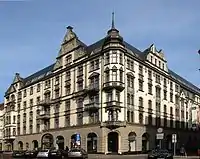
.jpg.webp)
Katowice did not originate as a medieval town. The city centre was beginning to form in the mid-19th century when it was part of the Kingdom of Prussia and had an ethnic German majority. The buildings of the time are decorated in an eclectic style (mostly Renaissance with elements of Baroque) and elements of Art Nouveau style (Polish: secesja). By the end of the nineteenth century the centre was being referred to as a "little Paris" due to the presence of Parisian-styled tenement houses.[39] Examples of Modernism, especially International Style and Bauhaus inspired architecture, still coexist with modern office buildings in central Katowice. Between the 1950s and 1980s many socialist apartment blocks were constructed around the inner suburbs. Notable examples from that period include a multipurpose arena complex called Spodek and parts of Koszutka district.[40]
Katowice is one of the few cities in Poland where nearly all architectural styles are present. For instance, the Market square in Katowice (Polish: Rynek Katowicki) is surrounded by a vast majority of buildings and edifices representing styles such as neoclassicism, modernism, socialist realism and contemporary-modern. Some tenements have neogothic elements, which are an outstanding example of this type in Central and Eastern Europe. The street outlines, especially within the older inner districts, closely resemble the ones in Paris. Representational boulevards and promenades were established despite the city's strong industrial character. These, however, mostly adorned the city center and not working-class outer suburbs.
Unfortunately many old majestic buildings were demolished in the 1950s to make space for monumental modern blocks. Among other reasons for their destruction was the immense architectural detail which once represented the wealth of local industrialists and property owners. This particularly didn't fit in with the Socialist-Communist authority at the time.
Today, the marketplace and several nearby streets with shopping promenades are closed to traffic.
Tourist attractions
- Market square and adjacent streets: Warszawska, Teatralna, Dyrekcyjna, Staromiejska, Dworcowa, św. Jana, Pocztowa, Wawelska, 3 Maja, Stawowa, Mielęckiego, Starowiejska and Mickiewicza, the so-called "Great Market Square of Katowice" or "Old town of Katowice"—many historic (monument) buildings. This is a group of functional-architectural. On the market square and most of the above-mentioned streets are prohibitions or restrictions on cars. Streets: Staromiejska, Dyrekcyjna, Wawelska, Stawowa and Warszawska is lined decorative cobblestone creating a pedestrian zone. The authority plans to Katowice—Quarter streets: św. Jana, Dworcowa, Mariacka, Mielęckiego, Stanisława and Starowiejska is to become so "small market square".[41]
- Nikiszowiec – historical settlement of Katowice, candidate to UNESCO
- Cathedral of Christ the King
- St Mary's Church
- Church of the Resurrection, Evangelical-Augsburg, built in 1856–1858
- Church of St Michael Archangel, the oldest church in the city, built in 1510
- Drapacz Chmur, one of the first skyscrapers in Europe
- Silesian Parliament, built in 1925–1929. For a very long time, it was the biggest structure in Poland
- Modernist old town
- Spodek (a large sports centre/concert hall, whose name translates as the 'saucer', from its distinctive shape resembling a UFO flying saucer)
- Silesian Insurgents Monument (Polish: Pomnik Powstańców Śląskich), the largest and heaviest monument in Poland. It is a harmonious combination of architecture and sculpture with appropriate symbolism: the wings symbolize the three Silesian Uprisings 1919 – 1920 – 1921 while the names of places that were battlefields are etched on the vertical slopes. The monument, which was funded by the people of Warsaw for Upper Silesia, is considered Katowice's landmark.
2.jpg.webp) Scientific Information Center and Academic Library
Scientific Information Center and Academic Library - Silesian Theater, built in 1907
- Rialto Cinetheater, built in 1912
- Silesian Museum, built in 1899
- Old train station in Katowice, built in 1906
- The Goldstein Palace
- The Załęże Palace
- Parachute Tower – a 50 m (160 ft) tall lattice tower was built in 1937 for training parachutists. It was used in the first days of World War II and is the only parachute tower in Poland.
Other:
- Franciscan Monastery in Panewniki
- Church of St Joseph (Załęże)
- St Stephen's Church
- Church of Christ Resurrection
- The Monument to Marshal Piłsudski by Croatian sculptor Antun Augustinčić, 1937–39. It was commissioned in 1936 but brought to Poland in 1991
- Monopol Hotel
- Katowice Rondo, the large square/roundabout, reconstructed recently, with the semi-circular Galeria Rondo Sztuki in the centre.
- The Altus Skyscraper, the tallest skyscraper
Economy
.jpg.webp)
Despite relatively small size, Katowice is one of the major industrial, commerce and financial hubs of Poland.
Katowice enjoys a very strong job market. Despite being 11th city in Poland in terms of population, Katowice is the 7th largest number of employed, with 171,839 full-time positions as of 2019. Katowice is also second only to Warsaw in number of commuters coming from other municipalities to work in the city, at 113,830 commuting to work in Katowice.[42] Unemployment rate in Katowice regularly ranks among the lowest in the country, and as of August 2020 it is the lowest in Poland at 1.5% (3,300 unemployed).[43] As of 2018, Katowice had 10th highest salaries in Poland, at PLN 5,698.98 on average.[44]
Katowice transformed its economy from a heavy industry-based to professional services, education and healthcare. As of 2020, it is classified as global Gamma- city according to Globalization and World Cities Research Network, on par with Poznan, Cleveland or Bilbao.[45]
Industry
Since its creation, Katowice's development was tightly connected to heavy industry, especially coal mining, steelworks and machine production. In 1931, 49.5% of inhabitants worked in industry, and 12.5% in coal mining alone. In 1989 industry accounted for 36% of all jobs in the city (112,000 employees). As of 2018, 34,294 people worked in industry in Katowice, 20.4% of total - below the national average.
The first reported coal mine in Katowice (Murcki coal mine) was established in 1740, and in 1769 construction on Emanuelssegen mine started. As the demand for coal kept rising in the Kingdom of Prussia, further mines were opened: Beata (1801), Ferdinand (1823), Kleofas (1845). Later in 19th and early 20th century additional mines were opened: Katowice, Wujek, Eminenz (later renamed Gottwald and merged with Kleofas), Wieczorek, Boże Dary, Staszic and renewed Murcki. Currently two remain in operation: Wujek (scheduled to close in 2021) and Murcki-Staszic. Katowice is also the seat of Polska Grupa Górnicza, the largest coal mining corporation in Europe.
Metallurgy was another important part of Katowice's economy. In 1863 a dozen zinc metallurgy facilities were reported in Katowice, with Wilhelmina (founded in 1834) being the largest. In early 1900s, Wilhelmina (later renamed Huta Metali Niezależnych Szopienice) was enlarged and became the largest Silesian producer of non-ferrous metals and world's largest producer of cadmium. Two major steelworks existed in the city: Huta Baildon, established in 1823 by the Scottish engineer and industrialist John Baildon (declared bankruptcy in 2001), and Huta Ferrum, established in 1874 and operating to this date in limited capacity.
Business and commerce
Following the collapse of heavy industry in late 20th century, Katowice had to transform its economy towards more modern sectors. As a result, Katowice is a large business, conference and trade fair center.
Katowice is headquarters to 18 public companies traded on the Warsaw Stock Exchange, with total market value of PLN 24.2 billion as of 2016, with the largest being ING Bank Śląski.[46] As of 2019, 38 companies from Katowice make the list of 2000 largest enterprises in Poland according to Rzeczpospolita, with largest one being Tauron Polska Energia S.A. (10th place).[47] As of 2012, 44,050 companies were registered in Katowice, almost 10% of all companies in the Silesian Voivodeship.
Retail is a very strong sector in Katowice. The city is home to several shopping centers and department stores, with Silesia City Center and Galeria Katowicka being the largest ones. Silesia City Center, located on a brownfield in place of a former coal mine, is the largest shopping center in Poland when number of stores is considered (310 different brands)[48] and 7th largest in terms of retail space for rent (86,000 sq. m).[49] It is also a part of a broader revitalization complex, that features an apartment complex and office space (under construction as of October 2020) as well.
Katowice is also the seat of Katowice Special Economic Zone (Katowicka Specjalna Strefa Ekonomiczna).
Culture
Katowice is the cultural centre of the entire Silesian agglomeration inhabited by over two million people and one of the leading cultural spots in Poland.[50] Most importantly, it is a host city to some of the biggest theatrical and stage events. This also includes hosting gatherings and exhibitions as well as film and musical events. Annual musical festivals such as the Rawa Blues, the Tauron New Music Festival, the Silesian Jazz Festival, the Mayday Festival and other concerts, which attract yearly hundreds of thousands of tourists from the entire country. Katowice also temporarily hosts the OFF Festival, the most important alternative event in Poland.[50]
Katowice is the seat of an internationally renowned Karol Szymanowski Academy of Music, as well as the Polish National Radio Symphony Orchestra. The Silesian Philharmonic also has its seat in Katowice. The opening of a new architectural complex of the National Polish Radio Orchestra took place in 2014.
A showcase for Katowice is the "Camerata Silesia" – an ensemble aimed at promoting the city in Poland and overseas. Classical music also plays a significant role in Katowice and the city annually becomes a venue for numerous classical concerts and festivals. The list includes an International Festival of Young Music Competition Laureates, Grzegorz Fitelberg International Competition for Conductors, Chamber Music Festival, Ars Cameralis Festival and Katowice's opera, operettas and most of all ballet. In 2010, as part of the Chopin Year Celebrations, Katowice held the International Chopin Knowledge Challenge, which took place at the Spodek hall.
The BWA Contemporary Art Gallery in Katowice, established in 1949, is a notable institution concerning the Contemporary arts.[51] Every three years, it is responsible for the organisation of the Polish Graphic Art Triennial. Several other galleries feature exhibitions of the works by artists from abroad along with film screenings, workshops for children and public fairs. The Silesian Museum in Katowice, opened in 1929, exhibits works by famous and renowned Polish artists like Józef Chełmoński, Artur Grottger, Tadeusz Makowski, Jacek Malczewski, Jan Matejko, Józef Mehoffer and Stanisław Wyspiański.[50]
List of notable attractions:



- Silesian Theatre, named after the Polish writer and painter Stanisław Wyspiański, is the largest theatre in Silesia. It is located exactly in the central part of the market square facing westward. The complex was originally built as a German theatre between 1905 and 1907 by architect Carl Moritz.
- Silesian Museum, founded in 1929 by the Silesian Sejm, while the region was recovering from the Silesian uprisings. In the Polish interbellum (1918–1939), the Silesian Museum was one of the prime institutions within the Second Polish Republic.
- Silesian Philharmonic, originally established in 1945, its most notable members included Witold Małcużyński, Igor Oistrakh, Sviatoslav Richter and Adam Taubitz.
- Polish National Radio Symphony Orchestra, created in 1935 and led by Grzegorz Fitelberg until the outbreak of World War II, has recorded nearly 200 compact discs for many domestic and foreign labels.
- Off Festival, a music festival, which also supports a variety of independent arts and cultural events such as exhibitions, workshops and film screenings.
- Rawa Blues Festival, the world's largest indoor blues festival named after the Rawa River, which flows through Katowice.
Media
- TV stations:
- TVP 3 Katowice
- TVS (TV Silesia)
- TVN24 – department Katowice (TVN24 – oddział Katowice)
- radio stations:
- newspapers:
- Dziennik Zachodni
- Gazeta Wyborcza – Katowice section
- Fakt – Katowice section
- Metro International – Katowice
- Nowy Przegląd Katowicki
Festivals and events
- Rawa Blues Festiwal – Spodek
 Tauron New Music Festival
Tauron New Music Festival - Metalmania – Spodek
- Off Festival
- Mayday – Spodek
- International Competition of Conductors by Fitelberg
- International Cycling Film Festival
- International Festival of Military Orchestras
- International Exhibition of Graphic arts "Intergrafia"
- The ESL One Katowice Tournament, for the popular FPS Counter-Strike: Global Offensive, League of Legends, and Starcraft II is held every year.
- Tauron New Music Festival
- Intel Extreme Masters World Championship, one of the biggest eSports events in the world[52]
- COP24 On 3–14 December 2018, Poland will host the 24th Session of the Conference of the Parties to the United Nations Framework Convention on Climate Change(UNFCCC COP24)and the meeting will be held in Katowice.[53]
Parks and squares
- parks:
- Silesian Park (Wojewódzki Park Kultury i Wypoczynku)
- Kościuszko Park (Park im. Tadeusza Kościuszki)
- Forest Park of Katowice (Katowicki Park Leśny)
- Valley of Three Ponds (Dolina Trzech Stawów)
- Zadole Park
- squares:
- Katowice market square (Rynek w Katowicach)
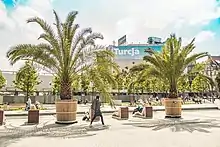 Palms on Katowice market square during summer holidays
Palms on Katowice market square during summer holidays - Freedom Square (Plac Wolności)
- Andrzej Square (Plac Andrzeja)
- Miarka Square (Plac Miarki)
- Council of Europe Square (Plac Rady Europy)
- Alfred Square (Plac Alfreda)
- A. Budniok Square (Plac A. Brudnioka)
- J. Londzin Square (Plac J. Londzina)
- A. Hlond Square (Plac A. Hlonda)
Nature reserves and ecological areas
- Nature reserve Las Murckowski
- Nature reserve Ochojec
- Szopienice-Borki
- Źródła Kłodnicy
- Staw Grunfeld
- Stawy Na Tysiącleciu
- Płone Bagno
Education
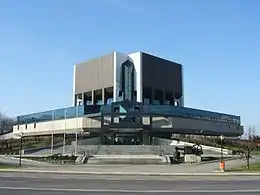
Katowice is a large scientific centre. It has over 20 schools of higher education, at which over 100,000 people study.
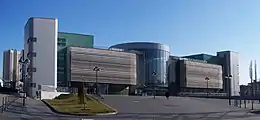
- University of Silesia in Katowice
- University of Economics in Katowice
- Medical University of Silesia
- Silesian University of Technology
- University of Social Sciences and Humanities
- Karol Szymanowski Academy of Music
- Akademia Lospuma Training Institute
- Academy of Fine Arts in Katowice
- Academy of Physical Education im. Jerzy Kukuczka in Katowice
- Higher Silesian Seminary in Katowice
There are also:
- around 80 high schools
- around 35 gimnasia
- around 55 primary schools
- around 50 libraries, including the Silesian Library
Transport
Public transport
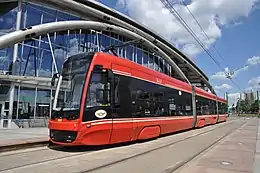
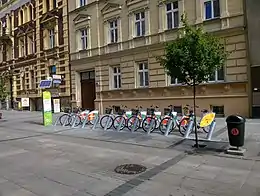
The public transportation system of the Katowice and Upper Silesian Metropolis consists of four branches—buses, trams and Trolleybuses united in Zarząd Transportu Metropolitalnego (lit. Metropolitan Transport Authority)[54] as well as the regional rail (primarily Koleje Śląskie and Przewozy Regionalne). Additional services are operated by private companies and state-owned railways.
- Trams
Silesian Interurbans – one of the largest tram systems in the world, in existence since 1894. It spreads for more than 50 kilometres (31 miles) (east-west) and covers 14 districts of the Upper Silesian Metropolis.
- Buses
Roads
- European route E40 (France–Belgium–Germany–Poland–Ukraine–Russia–Uzbekistan–Kazakhstan)
.JPG.webp) National road 79 in Katowice
National road 79 in Katowice - European route E75 (Vardø, Norway–Finland–Poland–Slovakia–Hungary–Serbia–Macedonia–Greece)
- European route E462 (Czech Republic–Poland)
- Motorway A4 (German/Polish border – Wrocław – Katowice – Kraków – Rzeszów – Polish/Ukrainian border)
- National road 79
- National road 81
- National road 86
Several important roads in neighbourhoods of Katowice (USMU):
- Motorway A1 (Gdańsk – Toruń – Łódź – Gliwice – Polish/Czech border)
- Expressway S1
- National road 11
- National road 44
- National road 78
- National road 88
- National road 94
Airports
The city and the area are served by the Katowice International Airport, about 30 km (19 mi) from the city center. With 3 terminals and over 4,8 million passengers served in 2018, it is by far the biggest airport in Silesia.[55]
Because of the long distance to the airport, there is a proposal to convert the much closer sport aviation Katowice-Muchowiec Airport into a city airport for smaller, business-oriented traffic.
Railways
Upper Silesian Railway reached the area in 1846. Katowice Central Station is one of the main railway nodes and exchange points in Poland. It has replaced the old Katowice historic train station. The city has direct connections among others with Warsaw, Cracow, Szczecin and Gdynia.
Sports
Katowice has a long sporting tradition and hosted the final of EuroBasket 2009 and 1975 European Athletics Indoor Championships, 1975 European Amateur Boxing Championships, 1976 World Ice Hockey Championships, 1957, 1985 European Weightlifting Championships, 1974, 1982 World Wrestling Championships, 1991 World Amateur Bodybuilding Championships, 2011 Women's European Union Amateur Boxing Championships, 2014 FIVB Men's World Championship and others.
The Silesian Stadium is between Chorzów and Katowice. It was a national stadium of Poland, with more than 50 international matches of the Poland national football team played here and around 30 matches in UEFA competitions. There were also a Speedway World Championship, Speedway Grand Prix of Europe and many concerts featuring international stars.
Tourists can relax playing tennis or squash, doing water sports also sailing (for example—in Dolina Trzech Stawów), horse-riding (in Wesoła Fala and Silesian culture and refreshment park), cycling or going to one of numerous excellently equipped fitness clubs. Near the city center are sporting facilities like swimming pools (for example "Bugla", "Rolna") and in neighbourhood—Golf courses (in Siemianowice Śląskie).
Sports clubs
- GKS Katowice – men's football, (Polish Cup winner: 1986, 1991, 1993; Polish SuperCup winner: 1991, 1995; 1st league in 2003/2004 and 2004/2005 seasons). ice hockey team Champion: 1958, 1960, 1962 Górnik Katowice / GKS 1965, 1968, 1970.
- 1. FC Kattowitz – football club, vice-champion of Poland: 1927; champion of Upper Silesia: 1907, 1908, 1909, 1913, 1922, 1932, 1945
- AZS AWF Katowice – various sports, women's handball team playing in Polish Women's Handball Superleague, men's basketball team playing in the second league, fencing section – many medals in the Polish Championship
- Naprzód Janów Katowice – hockey club playing in Polish Hockey Superleague, vice-champion of Poland (5x): 1971, 1973, 1977, 1989, 1992; bronze medal (7x): 1972, 1974, 1976, 1978, 1982, 1986, 1987; Polish Cup (1x): 1970.
- AZS US Katowice – various sports, many medals in the Polish Championship in various sports
- HKS Szopienice – various sports, many medals in the Polish and Europe and World Championship in weightlifting
- Silesia Miners – American football club playing in Polish American Football League, Polish champion in 2009, vice-champion in 2007
- Jango Katowice – futsal club playing in Polish Futsal Superleague; Polish Cup (1x): 2007; bronze medal Polish Championship (2x): 2001, 2007
- Rozwój Katowice – football club playing in Polish Third League
- MK Katowice – football club playing in Polish Fourth League
- Hetman Szopienice – chess club, many medals in the Polish Championship
- Sparta Katowice – various sports, many medals in the Polish Championship in various sports
- Policyjny Klub Sportowy Katowice – various sports, many medals in the Polish Championship in various sports
- AWF Mickiewicz Katowice – basketball club
- Silesian Flying club (Aeroklub Śląski)
Defunct sports clubs:
- Diana Kattowitz – football club
- Germania Kattowitz – football club
- KS Baildon Katowice – various sports, many medals in the Polish Championship in various sports
- Pogoń Katowice – various sports, many medals in the Polish Championship in various sports
Sports events
- 1975 European Athletics Indoor Championships
- 1976 World Ice Hockey Championships
- FIVB World League 2001
- FIVB World League 2007
- Eurobasket 2009
- Tour de Pologne 2010
- BNP Paribas Katowice Open
- EMS One Katowice 2014 (CS:GO Major Championship)
- IEM World Championship Katowice 2015
- ESL One Katowice 2015 (CS:GO Major Championship)
- IEM World Championship Katowice 2016
- IEM World Championship Katowice 2017
- Overwatch World Cup 2017 Qualifier
- IEM World Championship Katowice 2018
- IEM World Championship Katowice 2019 (CS:GO Major Championship)
- ESL One Katowice 2019[56]
- BWF World Senior Badminton Championships 2019[57]
Notable people
- Hans Sachs (1877–1945), serologist
- Kurt Goldstein (1878–1965), neurologist
- Erich Przywara (1889–1972), priest
- Hans Mikosch (1898–1993), general
- Hans Källner (1898–1945), general
- Franz Leopold Neumann (1900–1954), politician
- Willy Fritsch (1901–1973), actor
- Hans Bellmer (1902–1975), surrealist photographer
- Hans-Christoph Seebohm (1903–1967), politician
- Maria Goeppert-Mayer (1906–1972), physicist, Nobel Prize winner
- Kurt Schwaen (1909–2007), composer
- Rudolf Schnackenburg (1914–2002), priest
- Georg Thomalla (1915–1999), actor
- Ernst Wilimowski (1916–1997), football player
- Ernst Plener (1919–2007), football player
- Anneli Cahn Lax (1922–1999), mathematician
- Richard Herrmann (1923–1962), football player
- Chaskel Besser (1923–2010), Orthodox rabbi
- Kazimierz Kutz (born 1929), film director and politician
- Waldemar Świerzy (1931–2013), artist, illustrator and cartoonist
- Wojciech Kilar (1932–2013), classical and film music composer
- Janusz Sidło (1933–1993), javelin thrower
- Henryk Górecki (1933–2010), classical composer
- Josef Kompalla (born 1936), ice hockey player and referee
- Henryk Broder (born 1946), journalist
- Jerzy Kukuczka (1948–1989), alpine and high altitude climber
- Grzegorz Kosok (born 1986), volleyball player
- Zuzanna Bijoch (born 1994), fashion model
Twin towns – sister cities
References
Notes
- "Local Data Bank". Statistics Poland. Retrieved 21 June 2020. Data for territorial unit 2469000.
- "Study on Urban Functions (Project 1.4.3)" Archived 24 September 2015 at the Wayback Machine – European Spatial Planning Observation Network, 2007
- "Katowice". Lexico UK Dictionary. Oxford University Press. Retrieved 2 August 2019.
- "Katowice". The American Heritage Dictionary of the English Language (5th ed.). Boston: Houghton Mifflin Harcourt. Retrieved 2 August 2019.
- "Katowice, Poland – A City Guide – Cracow Life". Archived from the original on 16 March 2017. Retrieved 15 March 2017.
- "Local history – Information about the town – Katowice – Virtual Shtetl". Archived from the original on 16 March 2017. Retrieved 15 March 2017.
- o.o., StayPoland Sp. z. "History of Katowice". Archived from the original on 16 March 2017. Retrieved 15 March 2017.
- "History". Archived from the original on 16 March 2017. Retrieved 15 March 2017.
- "Liberation Memorial Katowice - Katowice - TracesOfWar.com". Archived from the original on 16 March 2017. Retrieved 15 March 2017.
- "CityProfiles: Katowice". The Urban Audit. Archived from the original on 29 February 2012. Retrieved 15 August 2012.
- "Redefining Global Cities". Brookings Institution.
- "The World According to GaWC 2020". GaWC - Research Network. Globalization and World Cities. Retrieved 3 September 2020.
- Interim Territorial Cohesion Report Archived 23 April 2013 at the Wayback Machine – Preliminary results of ESPON and EU Commission studies
- "Global city GDP 2011". Brookings Institution. Archived from the original on 5 June 2013. Retrieved 26 December 2012.
- "Katowice – a city of music". Archived from the original on 1 August 2018. Retrieved 31 July 2018.
- silnet.pl. "Historia miasta i dzielnic – Katowice". Archived from the original on 2 February 2017. Retrieved 25 January 2017.
- "History – Katowice". Archived from the original on 16 March 2017. Retrieved 15 March 2017.
- Von Krakau bis Danzig (in German). Thomas Urban. 2004. ISBN 9783406510823. Archived from the original on 24 October 2012. Retrieved 21 March 2009.
- Documents on British foreign policy, 1919-1939 Great Britain. Foreign Office, Ernest Llewellyn Woodward page 44
- "Katowice, Poland". Archived from the original on 18 March 2017. Retrieved 17 March 2017.
- Centre, UNESCO World Heritage. "Historic Centre of Warsaw". Archived from the original on 15 March 2017. Retrieved 17 March 2017.
- Woźniczka, Zygmunt. "Katowice zniknęły. Powstał Stalinogród. To już 61 lat". Archived from the original on 16 March 2017. Retrieved 15 March 2017.
- "Jak Katowice Stalinogrodem się stały – HISTORIA.org.pl – historia, kultura, muzea, matura, rekonstrukcje i recenzje historyczne". 10 December 2013. Archived from the original on 2 April 2017. Retrieved 15 March 2017.
- "Jak Katowice zamieniono na Stalinogród". Archived from the original on 16 March 2017. Retrieved 15 March 2017.
- www.wirtualnyturysta.com, Wirtualny Turysta. "Katowice Online – Stalinogrod – Post-War History of Katowice". Archived from the original on 16 March 2017. Retrieved 15 March 2017.
- Witosławska, Agata. "Katowice – the capital city of Upper Silesia". Archived from the original on 28 August 2017. Retrieved 15 March 2017.
- "Katowice – IFMSA SCOPE Wiki". Archived from the original on 16 March 2017. Retrieved 16 March 2017.
- "Катовице, Польша #12560". Retrieved 28 August 2009.
- (in Polish) dziennik.pl – "17 śląskich miast chce się połączyć w Silesię", 11 December 2006 Archived 30 September 2007 at the Wayback Machine)
- Lamparska, Marzena (1 June 2013). "Post-industrial Cultural Heritage Sites in the Katowice conurbation, Poland". Environmental & Socio-Economic Studies. 1 (2): 36–42. doi:10.1515/environ-2015-0011.
- o.o., StayPoland Sp. z. "Katowice – Tourism – Tourist Information – Katowice, Poland -". Archived from the original on 16 March 2017. Retrieved 16 March 2017.
- "GUS – Baza Demografia: Wyniki badań bieżących: Stan i struktura ludności: Ludność: 2017: Ludność stan w dniu 30 VI: Ludność według płci i miast: Śląskie". Archived from the original on 15 October 2014.
- "Silesia". Archived from the original on 1 March 2014. Retrieved 16 March 2017.
- "Holocaust – oshpitzin.pl". Archived from the original on 16 March 2017. Retrieved 16 March 2017.
- GUS. "Struktura narodowo-etniczna, językowa i wyznaniowa ludności Polski - NSP 2011". stat.gov.pl (in Polish). Retrieved 6 February 2021.
- "Wortal Publicznych Służb Zatrudnienia prowadzony przez Ministerstwo Rozwoju, Pracy i Technologii - aktualna strona : Statystyka". psz.praca.gov.pl. Retrieved 6 February 2021.
- "Education and training statistics at regional level - Statistics Explained". ec.europa.eu. Retrieved 6 February 2021.
- Redakcja (4 October 2020). "Miasta, w których średnie pensje są najwyższe i najniższe. Jak wypadają największe miasta z Podlaskiego? (tabela, zdjęcia)". Kurier Poranny (in Polish). Retrieved 6 February 2021.
- "Wydawnictwo Muzeum Śląskiego: Lech Szaraniec "Katowice w dawnej i współczesnej fotografii". Archived from the original on 22 May 2009. Retrieved 13 April 2009.
- "When did a "Flying Saucer" arrive in Katowice? – Katowice". 20 October 2016. Archived from the original on 17 March 2017. Retrieved 16 March 2017.
- Dziennik Zachodni Katowice – "Będą dwie Mariackie", 3 sierpnia 2007
- tuPolska. "Przyjezdni pracownicy - Katowice ustępują tylko Warszawie". www.slaskibiznes.pl (in Polish). Retrieved 13 October 2020.
- GUS. "Bezrobotni zarejestrowani i stopa bezrobocia. Stan w końcu sierpnia 2020 r." stat.gov.pl (in Polish). Retrieved 13 October 2020.
- "Średnie wynagrodzenie wg powiatów w Polsce - ranking 2018". 300Gospodarka.pl (in Polish). 8 November 2019. Retrieved 13 October 2020.
- "GaWC - The World According to GaWC 2020". www.lboro.ac.uk. Retrieved 13 October 2020.
- Kwestarz, Piotr (24 February 2016). "Interaktywna mapa ugiełdowienia Polski – sprawdź spółki w swoim mieście". StrefaInwestorow.pl (in Polish). Retrieved 13 October 2020.
- "Firmy szybsze niż PKB". www.rp.pl (in Polish). Retrieved 13 October 2020.
- B, Jakub; ura (3 July 2020). "Największe galerie handlowe w Polsce". Portfel Polaka (in Polish). Retrieved 13 October 2020.
- "TOP 10: Największe galerie handlowe w Polsce [FOTOGALERIA]". www.muratorplus.pl. Retrieved 13 October 2020.
- j., Media Partner Sp. "Culture: People: Invest in Katowice". Archived from the original on 25 March 2017.
- "Galeria Sztuki Współczesnej BWA w Katowicach – Miejsce – Culture.pl". Archived from the original on 25 March 2017.
- Fortune Magazine (3 March 2016) Poland Is Home to the Biggest eSports Event in the World "Archived copy". Archived from the original on 14 July 2016. Retrieved 25 July 2016.CS1 maint: archived copy as title (link)
- "COP24". cop24.gov.pl. Archived from the original on 28 April 2018. Retrieved 1 May 2018.
- Redakcja (31 December 2018). "Od 1 stycznia nie ma po co zaglądać na stronę KZK GOP. Gdzie szukać nowego rozkładu jazdy?". Infokatowice.pl (in Polish). Archived from the original on 21 April 2019. Retrieved 21 April 2019.
- "Katowice Airport". www.katowice-airport.com. Archived from the original on 21 April 2019. Retrieved 21 April 2019.
- "ESL One New York 2018 – Where CS:GO Legends Are Made". ESL One Katowice 2019. Archived from the original on 10 January 2019. Retrieved 10 January 2019.
- "KATOWICE TO HOST 'WORLD SENIORS'". Archived from the original on 5 December 2017. Retrieved 5 December 2017.
- "Współpraca międzynarodowa". katowice.eu (in Polish). Katowice. Retrieved 10 March 2020.
.jpg.webp)




